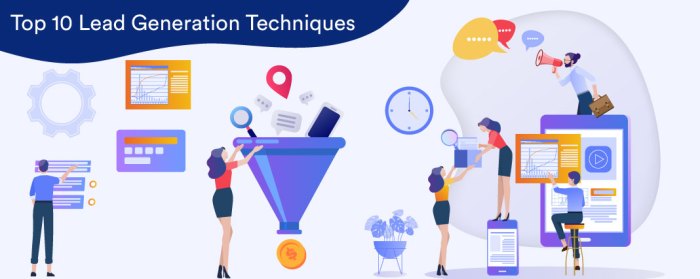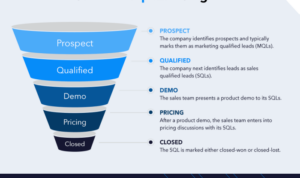Lead Generation Techniques are crucial for businesses looking to expand their reach and increase sales. In this hip guide, we’ll dive into the world of generating leads with style and finesse. Get ready to learn the secrets to success!
Lead Generation Techniques Overview
Lead generation is like the bread and butter for businesses – it’s essential for keeping the sales train chugging along. Without leads, there would be no customers to sell to, and that’s a one-way ticket to Bankruptsville. So, lead generation is basically the process of attracting potential customers and getting them interested in what you’re offering. It’s like fishing, but instead of worms and a fishing rod, you’re using killer marketing strategies to reel ’em in.
Importance of Lead Generation
Lead generation is the lifeblood of any business – it’s where the magic happens. By generating leads, you’re essentially creating a pipeline of potential customers who are interested in what you have to offer. This not only helps increase sales but also builds brand awareness and loyalty. Plus, with a solid lead generation strategy in place, you can target specific audiences and tailor your marketing efforts to maximize your ROI.
Key Goals of Lead Generation Techniques
– Capturing the attention of potential customers
– Building relationships with leads to nurture them into loyal customers
– Increasing brand visibility and awareness
– Driving sales by converting leads into paying customers
– Gathering valuable data and insights to optimize marketing strategies
Role of Lead Generation in Sales and Marketing Strategies
Lead generation is the fuel that keeps the sales and marketing engine running smoothly. It helps sales teams identify and prioritize high-quality leads, allowing them to focus their efforts on prospects who are most likely to convert. On the marketing side, lead generation provides valuable data and feedback that can be used to refine targeting strategies and improve campaign performance. Ultimately, lead generation is the bridge that connects marketing and sales, driving revenue and growth for businesses.
Inbound Lead Generation

Inbound lead generation is all about attracting potential customers to your business through valuable content and interactions. This approach focuses on creating a strong online presence and establishing credibility to draw in leads naturally.
When comparing inbound vs. outbound lead generation strategies, inbound is more customer-centric and focuses on building relationships with prospects through personalized content and targeted marketing efforts. On the other hand, outbound lead generation involves reaching out to potential customers through cold calls, emails, and advertisements.
Examples of Effective Inbound Lead Generation Tactics
- Content Marketing: Creating informative blog posts, videos, and social media content to educate and engage your target audience.
- Search Engine Optimization (): Optimizing your website and content to rank higher in search engine results and attract organic traffic.
- Social Media Marketing: Utilizing platforms like Facebook, Instagram, and LinkedIn to share valuable content, engage with followers, and drive traffic to your website.
- Email Marketing: Sending personalized and relevant emails to nurture leads and guide them through the buyer’s journey.
- Webinars and Events: Hosting online webinars or in-person events to showcase your expertise, engage with prospects, and generate leads.
Outbound Lead Generation: Lead Generation Techniques
When it comes to outbound lead generation, it involves reaching out to potential customers rather than waiting for them to come to you. This proactive approach allows businesses to target specific audiences and generate leads through various methods.
Methods of Outbound Lead Generation
- Cold calling: This method involves calling potential leads who have not expressed any interest in your products or services.
- Email marketing: Sending promotional emails to a list of prospects to generate interest and leads.
- Direct mail: Sending physical mail, such as postcards or brochures, to targeted individuals or businesses.
Pros and Cons of Outbound Lead Generation
Outbound lead generation has its own set of advantages and disadvantages:
- Pros:
- Ability to reach a large audience quickly.
- Directly target specific demographics.
- Can generate immediate results.
- Cons:
- Can be seen as intrusive by recipients.
- Higher cost compared to inbound methods.
- Lower conversion rates compared to inbound leads.
Best Practices for Implementing Outbound Lead Generation Techniques
- Personalize your outreach efforts to make them more engaging and relevant to the recipient.
- Use a multi-channel approach by combining different outbound methods for better results.
- Track and analyze your campaigns to optimize performance and improve lead generation efforts.
Online Lead Generation

Online lead generation is crucial for businesses looking to expand their customer base and increase sales in the digital age. Leveraging various online channels can help companies reach a wider audience and attract potential leads. Let’s explore some effective strategies for online lead generation.
(Search Engine Optimization)
plays a vital role in online lead generation by improving a company’s visibility in search engine results. By optimizing website content with relevant s and creating high-quality backlinks, businesses can attract organic traffic and generate leads.
- Perform research to target specific search terms related to your products or services.
- Create valuable content that resonates with your target audience and encourages engagement.
- Optimize meta tags, headings, and images to improve search engine rankings.
- Monitor website performance using analytics tools to track the effectiveness of your efforts.
Social Media Marketing
Social media platforms offer a valuable opportunity for businesses to connect with potential leads and drive engagement. By creating compelling content, interacting with followers, and running targeted ads, companies can effectively generate leads through social media channels.
- Identify the most relevant social media platforms for your target audience and establish a strong presence on those channels.
- Engage with followers by responding to comments, messages, and mentions in a timely manner.
- Create and share engaging content, such as videos, infographics, and polls, to attract and retain followers.
- Run targeted social media ad campaigns to reach specific demographics and drive traffic to your website or landing pages.
Email Marketing
Email marketing remains a powerful tool for lead generation, allowing businesses to nurture relationships with prospects and convert them into customers. By sending personalized and relevant emails, companies can keep leads engaged and move them through the sales funnel.
- Segment your email list based on demographics, interests, and behavior to send targeted content to different groups of leads.
- Create compelling subject lines and email copy that entices recipients to open and engage with your emails.
- Include clear calls-to-action (CTAs) in your emails that prompt leads to take the desired action, such as signing up for a webinar or making a purchase.
- Analyze email performance metrics, such as open rates and click-through rates, to optimize your email marketing campaigns and improve lead generation results.
Offline Lead Generation
Offline lead generation refers to traditional methods of acquiring leads outside of digital platforms. While online lead generation has become increasingly popular, offline strategies still hold relevance in today’s digital age.
Traditional Methods for Offline Lead Generation
- Networking events: Attending industry conferences, trade shows, and local events to connect with potential leads face-to-face.
- Direct mail campaigns: Sending physical mailers, brochures, and postcards to targeted mailing lists to generate interest.
- Cold calling: Reaching out to potential leads via phone calls to introduce products or services and schedule follow-up meetings.
- Print advertising: Placing ads in newspapers, magazines, and local publications to reach a wider audience.
Relevance of Offline Strategies in a Digital Age
Offline lead generation strategies are still valuable because they offer a personal touch and human connection that digital methods sometimes lack. Face-to-face interactions at events or through direct mail can help build trust and credibility with potential leads. Additionally, offline strategies can complement online efforts by reaching audiences who may not be active online or who prefer traditional communication channels.
Examples of Successful Offline Lead Generation Campaigns
- Trade Show Booth: Setting up an engaging booth at a trade show with interactive displays and demonstrations to attract attendees and capture leads.
- Direct Mail Series: Sending a series of personalized direct mail pieces to a targeted list of prospects, each building on the previous one to create a sense of anticipation and interest.
- Networking Dinner: Hosting a networking dinner for industry professionals to foster relationships and generate leads in a relaxed and social setting.
Lead Nurturing Strategies
Lead nurturing is the process of building relationships with potential customers at every stage of the buyer’s journey. It involves understanding the needs and interests of leads and providing them with relevant information to move them closer to making a purchase.
Tools and Techniques for Effective Lead Nurturing
- Marketing Automation Platforms: Utilize tools like HubSpot, Marketo, or Pardot to automate email campaigns, lead scoring, and personalized content delivery.
- CRM Systems: Use Customer Relationship Management systems to track interactions with leads, segment them based on behavior, and tailor communication accordingly.
- Content Marketing: Create valuable and informative content that addresses the pain points of leads and guides them through the decision-making process.
- Lead Scoring: Implement a lead scoring system to prioritize leads based on their engagement level and readiness to buy.
Importance of Personalized Communication in Lead Nurturing
Personalized communication is crucial in lead nurturing as it helps build trust and establishes a connection with leads. By delivering tailored content and messages that resonate with the individual needs of leads, businesses can increase engagement and conversions. Personalization also shows that you understand the challenges and goals of your leads, making them more likely to choose your product or service.
